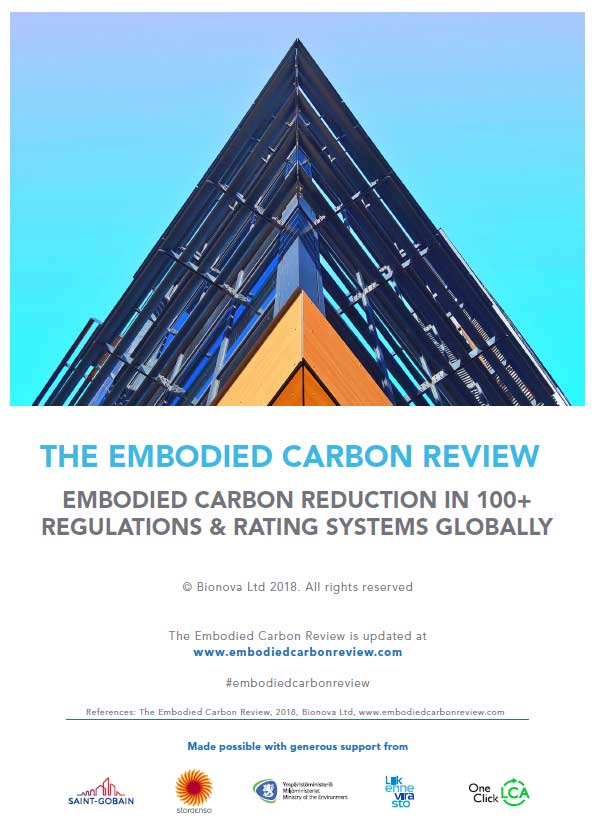The Embodied Carbon Review
The Embodied Carbon Review reports the results of how embodied carbon, that is, the carbon emissions from construction materials, is addressed in certifications and regulations globally. This unique research was conducted by Bionova Ltd (One Click LCA) and sponsored by Saint-Gobain, Stora Enso, Finnish Ministry of the Environment and the Finnish Transport Agency.
The growth of global urban population is driving unprecedented construction, resulting in embodied carbon emissions from new buildings in excess of 100 gigatons by 2060. If all construction activity, including infrastructure and renovations, are included, the global construction activity carbon until 2060 is set to exceed 230 gigatons, unless carbon intensity is drastically cut.
Embodied carbon has a short-term climate impact. If energy grids decarbonise, the embodied carbon from new buildings may remain the higher long-term emissions driver as well. As buildings become more energy-efficient and use more renewable energy sources, the proportional share of embodied carbon grows.
This review analysed environmental sustainability certifications and regulations applied to construction works used at least regionally. The study identified 156 such systems, of which 105 include measures addressing embodied carbon directly. National systems were identified in 26 countries.
Embodied carbon is addressed with methods of different carbon reduction efficiency, including carbon reporting, comparison in design, carbon rating, carbon caps, and mandatory offsetting. Embodied carbon reduction methods also vary in the ways the performance is rated, and if low-carbon product selection is included as a complementary measure.
Results are reported and analysed for five global regions, with all internationally used systems and civil engineering works-targeting systems analysed separately. Regions differ significantly in terms of the prevalence of embodied carbon targeting, as well as the level of sophistication for its reduction.
The report concludes with an explanation of the identified best practices for embodied carbon reduction, highlighting the successful cases of embodied carbon reduction in certification, regulation, and infrastructure, as well as an outlook for embodied carbon reduction in the future.
You can download the report for free here.
[edit] Related articles on Designing Buildings Wiki
- BREEAM.
- Building information modelling life cycle assessment IP 5 15.
- Carbon footprint.
- Chain of custody.
- Cradle-to-grave.
- Embodied carbon.
- Emission rates.
- Energy certificates.
- Energy related products regulations.
- Energy targets.
- India looks at using plastic instead of sand.
- Life cycle assessment.
- Life Cycle Costing BG67 2016.
- Performance gap.
- Sustainability.
- Sustainable materials.
- Utilising life cycle costing and life cycle assessment.
- Where does embodied carbon analysis stop?
- Whole life costs.
- Whole-life value.
Featured articles and news
CLC Health, Safety and Wellbeing Strategy 2025
Launched by the Minister for Industry to look at fatalities on site, improving mental health and other issues.
One of the most impressive Victorian architects. Book review.
Common Assessment Standard now with building safety
New CAS update now includes mandatory building safety questions.
RTPI leader to become new CIOB Chief Executive Officer
Dr Victoria Hills MRTPI, FICE to take over after Caroline Gumble’s departure.
Social and affordable housing, a long term plan for delivery
The “Delivering a Decade of Renewal for Social and Affordable Housing” strategy sets out future path.
A change to adoptive architecture
Effects of global weather warming on architectural detailing, material choice and human interaction.
The proposed publicly owned and backed subsidiary of Homes England, to facilitate new homes.
How big is the problem and what can we do to mitigate the effects?
Overheating guidance and tools for building designers
A number of cool guides to help with the heat.
The UK's Modern Industrial Strategy: A 10 year plan
Previous consultation criticism, current key elements and general support with some persisting reservations.
Building Safety Regulator reforms
New roles, new staff and a new fast track service pave the way for a single construction regulator.
Architectural Technologist CPDs and Communications
CIAT CPD… and how you can do it!
Cooling centres and cool spaces
Managing extreme heat in cities by directing the public to places for heat stress relief and water sources.
Winter gardens: A brief history and warm variations
Extending the season with glass in different forms and terms.
Restoring Great Yarmouth's Winter Gardens
Transforming one of the least sustainable constructions imaginable.
Construction Skills Mission Board launch sector drive
Newly formed government and industry collaboration set strategy for recruiting an additional 100,000 construction workers a year.
New Architects Code comes into effect in September 2025
ARB Architects Code of Conduct and Practice available with ongoing consultation regarding guidance.
Welsh Skills Body (Medr) launches ambitious plan
The new skills body brings together funding and regulation of tertiary education and research for the devolved nation.
Paul Gandy FCIOB announced as next CIOB President
Former Tilbury Douglas CEO takes helm.

























